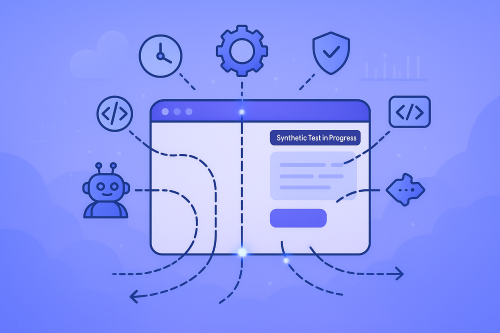Imagine traffic to your site or app that looks real but is intentionally generated. That’s synthetic traffic, a tool developers use to test, monitor, and optimize before real users show up.
What is synthetic traffic?
Synthetic traffic refers to artificially generated requests or sessions that mimic real user behavior. Developers and QA engineers use it to simulate how users interact with applications, websites, or networks.
Unlike real traffic, which comes from actual users, synthetic traffic is programmed. It follows specific patterns and behaviors designed to stress-test systems or validate performance under load.
For websites, synthetic traffic often involves scripts or bots that mimic clicks, scrolls, form submissions, and more. This lets teams verify how well their sites handle user flows, without waiting for real visitors.
It’s not about gaming SEO or inflating analytics. It’s about control, consistency, and confidence before the stakes are high.
Why do developers use synthetic traffic?
Performance testing under pressure
Synthetic traffic helps teams simulate high-traffic events, such as product launches or holiday sales. By flooding a system with controlled traffic, developers can measure performance metrics and identify bottlenecks before users encounter them.
Continuous monitoring and early alerts
In synthetic monitoring, developers set up synthetic checks to constantly test key functions, like logins or checkouts. If something breaks, alerts trigger before real users experience issues.
This proactive approach keeps downtime minimal and user trust intact.
A safe space for new features
New features can behave unpredictably. Instead of deploying untested code to real users, teams use synthetic traffic in staging environments. This ensures everything works under load before going live.
Privacy and compliance
When dealing with sensitive industries (like healthcare or finance), real user data may be restricted. Synthetic traffic allows development and QA teams to simulate activity without violating privacy laws.
Synthetic vs. real traffic: What’s the difference?
The power of real traffic
Real traffic comes from people interacting with your site. It reveals authentic behavior, decision paths, bounce rates, and session depth. It’s what search engines rely on for ranking signals.
What synthetic traffic offers instead
Synthetic traffic is predictable. You control what it does, when, and how often. That makes it ideal for automation and edge-case testing.
When to use each
- Use real traffic for insights, conversions, and SEO.
- Use synthetic traffic for testing, monitoring, and infrastructure health.
- Use both when possible. Synthetic ensures stability. Real traffic gives feedback.
Best practices for using synthetic traffic
Script what matters
Start with your most critical flows, login, add to cart, checkout. Simulate them as users would, step by step.
Keep it realistic
Mimic user agents, devices, locations, and time delays. A bot that acts like a human delivers better results.
Combine with real user monitoring (RUM)
Synthetic traffic is great for structure. Real user monitoring complements it with real-world nuance. Together, they give a full picture.
A well-configured traffic bot should replicate real-world conditions: device types, geographic locations, time delays, and browsing behavior. The more accurately it simulates user sessions, the more reliable your test results will be.
Focus on key metrics
Track response time, error rates, server load, time to first byte (TTFB), and resource usage. These tell you how your infrastructure behaves under pressure.
Avoid overreliance
Synthetic traffic can’t replace intuition or human behavior. It won't simulate indecision, random browsing, or frustration clicks. Use it wisely.
Risks and limitations of synthetic traffic
Oversimplified scenarios
If you don't simulate real user paths accurately, you might miss bugs. Simple scripts may not catch complex edge cases.
Lack of behavioral depth
Synthetic traffic won’t show how a confused customer navigates or how quickly someone bounces from a poor experience.
False security
Passing synthetic tests doesn’t mean your site is perfect. Issues may still arise once real users hit production.
Analytics skew
If not properly filtered, synthetic traffic can distort your site analytics. Always label or isolate it when running tests on live environments.
Real-world examples and workflows
Load testing a new homepage
Before launching a redesign, a development team uses synthetic traffic to simulate 50,000 visitors over an hour. They spot performance dips and fix image loading issues before launch.
Monitoring checkout reliability
An ecommerce site sets up synthetic monitoring for its payment process. If any step fails, alerts go to the dev team immediately, 24/7.
Deployment with canary testing
Using synthetic traffic, a company releases new features to 10% of users. They run synthetic flows across those sessions to verify functionality before a full rollout.
Where synthetic traffic fits in your SEO and analytics strategy
It’s not a traffic boost
Synthetic traffic won’t improve your search rankings. Google and other engines rely on real user behavior to determine quality and relevance.
But it supports uptime and readiness
If your site crashes when traffic surges, your SEO suffers anyway. Synthetic testing ensures your infrastructure handles demand.
Test before a campaign
Before running a big ad push or SEO campaign, simulate high traffic volumes. Make sure your site can handle success.
Blend it with real data
Use synthetic insights to optimize technical performance, then layer in real user analytics to improve experience and conversions.
The future of synthetic traffic
Smarter bots
AI and ML are making synthetic traffic more intelligent. Bots can mimic click hesitation, scroll patterns, and multitasking across tabs.
Broader simulation
Teams are simulating different geographies, devices, and network speeds. This helps brands support global audiences better.
Critical for complex systems
As web experiences become more dynamic, synthetic testing will be essential. It ensures every button click and microinteraction performs flawlessly—at scale.
Ready to optimize with confidence?
Synthetic traffic lets you test the unknown, monitor your site’s health, and stay ahead of failures. Want to combine performance insights with SEO growth? Try SearchSEO today.
Use synthetic insights to bulletproof your site and turn real visitors into loyal customers.


.svg)

.svg)
%201.png)








.svg)